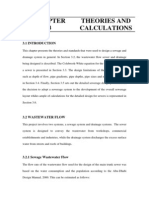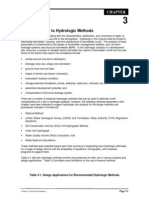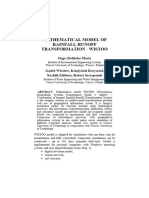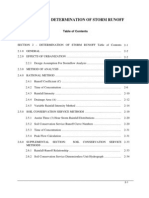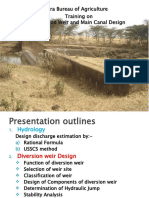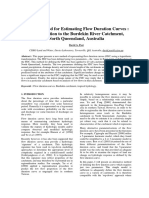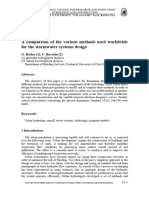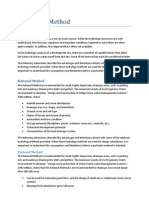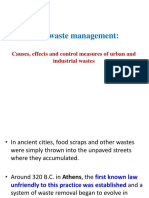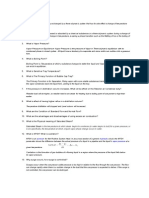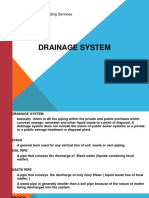0 ratings0% found this document useful (0 votes)
56 views2.3 Design of Hydrometeorological Data Networks
2.3 Design of Hydrometeorological Data Networks
Uploaded by
ravishnkThis document discusses the design of hydrometeorological data networks. It explains that networks of observational stations are set up to obtain spatial and temporal water resources data in a region. The key decisions in designing hydrologic networks are determining the variables to measure, station locations, instruments, and data collection systems. Coordination among independent agencies that operate these networks is important to reduce costs and improve data quality. The document then classifies different types of observation networks and discusses the design of precipitation and stream gauging networks.
Copyright:
© All Rights Reserved
Available Formats
Download as PDF, TXT or read online from Scribd
2.3 Design of Hydrometeorological Data Networks
2.3 Design of Hydrometeorological Data Networks
Uploaded by
ravishnk0 ratings0% found this document useful (0 votes)
56 views13 pagesThis document discusses the design of hydrometeorological data networks. It explains that networks of observational stations are set up to obtain spatial and temporal water resources data in a region. The key decisions in designing hydrologic networks are determining the variables to measure, station locations, instruments, and data collection systems. Coordination among independent agencies that operate these networks is important to reduce costs and improve data quality. The document then classifies different types of observation networks and discusses the design of precipitation and stream gauging networks.
Original Description:
NPTEL Lecture
Original Title
Lecture 2
Copyright
© © All Rights Reserved
Available Formats
PDF, TXT or read online from Scribd
Share this document
Did you find this document useful?
Is this content inappropriate?
This document discusses the design of hydrometeorological data networks. It explains that networks of observational stations are set up to obtain spatial and temporal water resources data in a region. The key decisions in designing hydrologic networks are determining the variables to measure, station locations, instruments, and data collection systems. Coordination among independent agencies that operate these networks is important to reduce costs and improve data quality. The document then classifies different types of observation networks and discusses the design of precipitation and stream gauging networks.
Copyright:
© All Rights Reserved
Available Formats
Download as PDF, TXT or read online from Scribd
Download as pdf or txt
0 ratings0% found this document useful (0 votes)
56 views13 pages2.3 Design of Hydrometeorological Data Networks
2.3 Design of Hydrometeorological Data Networks
Uploaded by
ravishnkThis document discusses the design of hydrometeorological data networks. It explains that networks of observational stations are set up to obtain spatial and temporal water resources data in a region. The key decisions in designing hydrologic networks are determining the variables to measure, station locations, instruments, and data collection systems. Coordination among independent agencies that operate these networks is important to reduce costs and improve data quality. The document then classifies different types of observation networks and discusses the design of precipitation and stream gauging networks.
Copyright:
© All Rights Reserved
Available Formats
Download as PDF, TXT or read online from Scribd
Download as pdf or txt
You are on page 1of 13
2.
3 Design of Hydrometeorological Data Networks
Data on temporal and spatial characteristics of water resources of a region are obtained by a
network of observational stations. Setting up a station requires investment for infrastructure
equipment, logistics, and for operation and maintenance. Scientific planning is necessary for
network design so that the desired results could be achieved with minimum cost.
Since the requirement of water resources data depends on their end use, it is difficult to
formulate general rules on network design. While designing hydrologic networks, the decisions
to be taken are:
i. the variables to be measured and the frequencies and duration of observations;
ii. the location of gauging stations;
iii. the instruments to be installed and methods of observation; and
iv. data observation and transmission system.
Since the hydrometeorological data networks are operated by a number of independent
agencies, a good coordination among them is important. This will reduce the expenditure and
improve data quality. Of particular importance is the coordination between hydromet, water
quantity and quality data networks.
2.3.1 Classification of Observation Networks
Hydro-meteorological observation networks can be classified in many different ways. Based on
spatial features, there are two types of networks:
a) areal networks, such as those for precipitation, and ground water levels, and
b) linear networks such as those for streamflow and river sediment.
Areal networks are established to get spatial characteristic of the variables over an area
while the linear networks are created for rivers, canals, etc. On the basis of purpose, the
networks can be classified in three categories: basic (to get the fundamental characteristics of the
variables of interest), specific (to gather data for some specific purpose, e.g., a reservoir project),
and temporary (which are in operation for a short period of time).
Another criterion for classification of hydro-meteorological networks could be the
purpose for which the network is established. The purpose of a basic network is to provide a
level of hydrological information at any location within its region of applicability that would
preclude any gross mistake in water resources decision making (WMO, 1994). In the early stages
of development of a network, the first step should be to set up a minimum network. Such a
network should consist of the minimum number of stations required to initiate planning for
utilization of water resources management in the region.
Depending on the purpose, the hydrological observation station could be classified into
three types:
1) Primary stations: These are also termed as key gauging stations, principal stations or
bench mark stations and are maintained on long term basis to generate representative
flow series of the river system.
2) Secondary stations: These are essentially short duration stations which are operated only
for short time period to establish the flow characteristics of the river.
3) Special purpose stations: These are also termed as specific purpose stations or project
stations or temporary stations meant for projects and are discontinued when the purpose
is served. The purpose could vary from design, management and operation of the project
to monitoring and fulfillment of legal agreement between co-basin states. Many a times,
the primary as well as the secondary stations also serve as special purpose stations.
The Guide to Hydrological Practices (2008) published by World Meteorological
Organization (www.wmo.ch) contains useful guidelines to set up networks for various types of
data, and observe and analyze the data. Bureau of Indian Standards (www.bis.org) have also
published various standards for Indian conditions.
2.4 Precipitation Networks
The optimum density of a precipitation gauge network depends on the purpose for which the data
are to be used. For example, measurements of precipitation for flood forecasting require denser
networks as compared to that for rainfall-runoff modeling. WMO (2008) has recommended the
following (Table 2.1) as minimum network densities for precipitation stations.
Table 2.1 Recommended minimum densities of stations (area in km
2
per station) [Source: WMO
(2008)].
Physiographic unit Precipitation Evaporation
Non-recording Recording
Coastal 900 9000 50000
Mountains 250 2500 50000
Interior plains 575 5750 5000
Hilly/undulating 575 5750 50000
Small islands 25 250 50000
Urban areas - 1020 -
Polar/arid 10000 100000 100000
The optimum network should make it possible to derive required information with desired
accuracy. The optimum number of rain gauge stations (N) in a network is given by (BIS 1968):
N =[C
v
/p]
2
(2.1)
where C
v
=the coefficient of variation of the precipitation values of the existing rain gauge
stations, and p =the allowable maximum percentage error in the estimate of basin mean rainfall.
A typical value of p is 10 percent. Here, C
v
is computed by
C
v
=100*s/P
m
(2.2)
In which s is the standard deviation and P
m
is the mean rainfall of the existing stations.
Obviously, a decrease in the percentage error would mean an increase in the number of gauges
required. Mukherjee and Kaur (1987) have proposed a modified form of eq. (2.1) by including
the mean correlation (r) of precipitation over the area
N =[C
v
/p]
2
(1 r) (2.3)
WMO recommends that the precipitation (amount and form) should be measured with an
accuracy of 37% and rainfall intensity with 1 mm/hr at the 95 per cent confidence interval.
Snow depth below 20 cm should be accuracy of less than 1 cm and depth above 20 cm should
not have more than 10% error. The recommended accuracy for evaporation range 25% and for
wind speed 0.5 m/sec.
Example 2.1: A catchment has 6 rain gauges and the annual rainfall at these has been measured
as 750, 540, 465, 493, 421, and 780 mm. Find out the optimum number of rain gauges for the
basin if the error of estimation is required to be kept below 10%.
Solution: For the data given, mean =574.83 mm and standard deviation =152.59 mm. Thus
C
v
=100*152.59/574.83 =26.54
Hence, using eq. (2.1), the optimum number of rain gauges for the basin (N) is
N =(26.54/10)
2
=7.04
This means that 7 rain gauge stations are required in the basin and the existing network of 6 rain
gauges is slightly inadequate. It needs to be strengthened by adding one new gauge so that the
estimate of rainfall depth has stipulated accuracy.
2.5 Stream Gauging Networks
A network of stream gauging stations is established in a river basin to provide data required by
the hydrologists for planning, development and management of water resources of the basin. The
collected data also enables to estimate the principal characteristics of the hydrological regime of
the basin.
Every major stream should be gauged near its mouth and its major tributaries should also
be gauged as feasible. Naturally, gauging depends on the existing and likely development in the
basin. According to WMO, the first gauging station is selected at the most upstream location
where the drainage area is about 1300 km
2
. The second station is located at a point in the
downstream direction where the drainage area is approximately doubled. The WMO
recommendations for a minimum density of stream gauging stations are given in Table 2.2.
Table 2.2 Recommended minimum densities of stations (area in km
2
per station) [Source: WMO
(2008)].
Physiographic unit Streamflow Sediments Water quality
Coastal 2750 18300 55000
Mountains 1000 6700 20000
Interior plains 1875 12500 37500
Hilly/undulating 1875 12500 47500
Small islands 300 2000 6000
Urban areas - - -
Polar/arid 20000 200000 200000
Stations are also established in the basin at the sites where significant changes in the
volume of flow are noticed, for example downstream of the confluence of a major tributary or at
the outflow point of a lake etc. In case a suitable location is not available downstream of the
confluence, the sites can be located upstream of the confluence, preferably on the tributary.
While establishing sites at the downstream of confluence, it should be ensured that no other
small stream joins the main river before the station so that correct assessment of the contribution
of the tributary to the main river is obtained.
The distance between two consequent stations on the same river may vary from about 50
km to several hundred kilometers, depending on many factors. The drainage area computed from
origin up to two consecutive observation sites on a large river should preferably differ by more
than ten percent so that the difference in quantities of flow at the two stations is significant.
Sometimes stations are set up due to hydrological significance, say, to determine the flow
contribution from a typical catchment.
A different approach is recommended for small independent rivers which flow directly
into the sea (for example, the rivers in Western Ghats). In such cases, the first hydrological
observation station is to be established on a stream that is typical of the region and further
stations are added to the network to cover the area and obtain information about the variability.
Stream in the area whose flows are low should not be avoided from the network. Absence of
stations from low flow streams may lead to wrong assessment of the surface water potential of
the area if it has been evaluated just on the basis of the data from the high flow streams. Thus,
great care is to be exercised to ensure that all distinct hydrological features are adequately
covered by the gauging network.
An existing gauging network needs periodic review. The developments that take place in
the basin like construction of new water resources development projects may warrant addition or
closure of the sites. Often the rivers are polluted by the discharge of affluents from industries. A
need may also arise to establish stations to monitor the quality of water in the river.
Regarding the accuracy desired in measuring river water depth and discharge, WMO
recommends that the water depth measurement should have accuracy of about 2%, velocity of
flow 25%, and discharge about 5%. Suspended sediment concentration should be estimated
with accuracy of 10%.
2.5.1 Network Design Process
Design of networks is not a one-time affair. Factors affecting network design go on evolving
with time and thus the networks also require periodic review and adjustments. Design of
networks to measure stream gauge and discharge involves the following steps:
1. Network design begins with collection of maps and background information about the
area/region. Usually 1:250,000 scale topographical maps of the river basin showing basin
boundaries will form the base map for the network design. Smaller scale maps are of
limited use because it is difficult to identify the location of stations relative to key
features. It is also important to use an updated map. Ideally, the following maps should
also be collected:
i. Existing precipitation and gauge-discharge gauging stations operated by various
departments.
ii. Location of existing and proposed water projects and command areas of
irrigation projects.
iii. Land use map, also showing forests, main industries and population centres.
iv. Communications map showing roads, rails, power transmission lines, canals, etc.
v. Map showing soil classification, geological formation and mining areas.
2. Define the objectives of the network: who will be the data users and what will the use of
data? What is the required frequency?
3. Evaluate the existing network and find out how well it meets the objectives?
4. Review existing database to identify gaps, ascertain variability in catchment behaviour.
5. Identify gaps and over-design (if any) in the existing network; new stations may be
proposed and existing stations deleted shifted.
6. Prioritise stations by following appropriate classification system.
7. Estimate average capital and recurrent costs of installing and maintaining different
categories of stations and overall cost of operating and maintaining the network.
8. Decide on approximate location of sites and carryout site surveys.
9. Review revised network in relation to overall objectives and available budget; adjust it as
necessary.
10. Prepare a realistic implementation plan which is achievable.
These steps and related topics are further elaborated in the following sections.
2.5.2 Criteria for Location of Stations
With particular reference to India, location of stream gauging stations is influenced by the
following factors:
Places where major rivers cross State borders;
Locations of proposed dams/diversion/run-of-river schemes including diversions or off-
takes/joining points for (proposed) inter-basin water transfers link canals;
Locations whose data may be needed for flood forecasting;
Conservation areas and areas of ecological interest;
Areas of water supply shortages;
Areas expected to have significant land use change, e.g., de-forestation or re-forestation;
2.5.3 Evaluation and Adequacy of Networks
To evaluate the networks, the existing network and proposed new stations should be marked on a
1:250,000 map. The catchment area for each river gauging station could be estimated from the
basin maps (hard copy or in GIS). Scanning the network systematically, the following questions
need to be considered for each station:
What purpose will the station fulfill?
Does a better location exist nearby?
Have any developments (e.g. dam construction) taken place or are likely which could
affect this station?
How close are the nearest upstream and downstream gauging stations? Two stations
should not be very close unless there are specific reasons.
Does any other organisation operate a gauging station in the vicinity? If yes, could the
data from that station serve the purpose expected from this station?
Based on the answers, stations which can be added, deleted or relocated are identified.
Financial Aspects
In addition to technical financial considerations are also important in network design because the
stations cannot be established without adequate money, equipment cannot be purchased and
operated, and staff cannot be hired. Hence, after the preliminary design of the network has been
completed, the expenditure to establish stations and the cost of operating them should be
estimated. These monetary requirements should match with the budget so that the proposed
network is sustainable. In case of deficit in the budget, the network should be re-aligned or
additional budget should be arranged. Stations in the network may be prioritized to best attain the
objectives, given the constraints. Table 2.3 gives a possible categorization of stations based on
their relative importance.
Table 2.3: A possible categorization of stations based on their relative importance
Category Priority Relative Importance
A High Sites of major water resources project(s): existing or proposed;
important rivers crossing state boundary, large basins that are still
ungauged, heavily polluted river.
B Medium Sites of medium scale water resources projects: existing or proposed,
medium size river crossing state boundary, operation of a medium
project, area with (potential) water quality problems. All of these
with an existing gauging site at some distance away.
C Low Minor irrigation project site, gauging station on small tributary, major
river but with nearby gauging sites.
Prior to removing/shifting an existing station in the network, the main users and beneficiaries of
the data should be consulted.
2.5.4 Site Selection Surveys
Once the objectives have been defined and the techniques for measurement/recoding water level
and flow measurement have been finalized, the site selection process can begin. To select the
most appropriate site for a station, site selection surveys are carried out. These surveys can be
divided into four distinct phases:
1. Desk study,
2. Reconnaissance surveys,
3. Topographic surveys, and other surveys.
By now, the target location for the gauging station will have already been identified on a
1:250,000 or similar map in earlier steps. However, 1:250,000 is too small a scale for final site
selection purposes. Large-scale topographic maps (1:50,000) should be checked to identify
possible sites within the target zone. Reconnaissance surveys should be undertaken by an
experienced hydrologist along with a person familiar with the area. As the hydraulic conditions
and river characteristics vary considerably from non-monsoon to monsoon season,
reconnaissance survey in both the seasons would facilitate correct decision on the suitability of
the site. When the establishment of site cannot wait that long, the suitability of the site for
hydrological observation could be decided after single inspection assisted by toposheet studies
and other relevant field investigations including measurements of width and depth.
At sites of interest, ownership of the land and approach should be ascertained. The site
shall be accessible in all seasons and all weather. It is important to use updated maps since most
surveys were completed several decades ago and things may have undergone large changes.
Recent situation can be obtained from remote sensing images or internet sites such as Google
Earth.
Information on the historical high flood level should also be collected (by local enquiry
and / or by examining the available landmarks) during the inspection. An all weather accessible
site located in a straight uniform reach free from weeds, rock outcrop, pools and back water
effect with stable non-overflowing banks with flow confined to single channel normal to the
selected cross-section of measurement would be an ideal site for stream gauging.
On completion of the reconnaissance surveys, one or more locations are shortlisted for
further consideration. After this, field surveys are carried out and the cross-section of the
proposed site is surveyed. If artificial controls (e.g. a weir) are planned, it will be necessary to
survey the river for some distance upstream and downstream to ascertain the impact on flows
and water levels. It will also be important to understand what type of control exists and to make
sure that the location will not be impacted by variable backwater effect of any structure.
2.5.5 General site selection guidelines
The following are the general site selection guidelines. Specific recommendations for different
types of stations are mentioned subsequently. It is emphasized that an ideal location which
satisfies all requirements can be found in very few real-life cases. In practice, it is often required
to take measurements in non-ideal conditions.
1) The approach channel should be of uniform cross-section and free from irregularities and
the flow shall have a regular velocity distribution. This can most readily be provided by
having a long, straight approach channel. There should be straight, uniform, well defined
approach channel upstream of the measuring section to ensure parallel and non-turbulent
flow. For rivers less than 100 m wide, a straight approach of 4 times channel width
should be preferred. For rivers more than 100 m wide, a straight approach channel of
minimum 400 m is desirable. When adequate length of straight channel is not present, the
straight length upstream should be at least twice that downstream.
2) Sites where high sediment deposition or scouring occurs or those which are subject to
weed growth should be avoided, if possible.
3) Locations which are subject to high turbulence or wind effects should be avoided.
4) In needs to be ensured that there is no parallel by-pass channel, natural or man-made, on
the surface or sub-surface, around the station.
5) The channel bed should be solid, relatively smooth and free from obstructions and debris.
6) The control shall be sensitive, such that a significant change in discharge, even for the
lowest discharges, should result in a significant change in stage. Small errors in stage
readings during calibration at a non-sensitive station can result in large errors in the
discharges indicated by the stage-discharge relationship.
7) The station should be located where the flood plain is at its narrowest and the out-of-bank
flood flow is the minimum. It is often not possible to locate a gauging station so that all
flood flows are contained within the river channel. At many locations, there is an
elevation after which out-of-bank flow occurs.
8) The banks of the river should be high and steep and free from larger vegetation. Some
vegetation is desirable since this helps maintain the stability of the banks.
9) River banks at the site should be well-defined, stable, and free from vegetation and other
obstructions.
10) Downstream conditions should preferably be stable. Sites, which are influenced by
downstream confluences with other rivers, river control structures, dams, tidal conditions
or heavy weed growth, should be avoided. Such downstream conditions should be taken
into account when designing the structure to assess the modular limit.
11) Factors such as unhindered access to the site in all seasons, availability of office
accommodation, living space for the observers, electricity and other services should also
be taken into account.
12) Enough land should be available near the site to install various instruments.
13) Human interference (out of curiosity or with malafide intention) with hydrometric
installations is a problem in India. This issue has to be given serious consideration during
the site selection process. For example if a choice has to be made between two
hydraulically similar sites, the final selection should be made in favour of the site which
has fewer problems due to human interference and law and order.
14) Sites with a tendency for formation of vortices, reverse flow or dead water shall be
avoided.
15) The measuring section should be away from obstructions (artificial and natural) and
control structures, e.g., dams, weirs.
16) Channel at measuring section should be free from weed growth, accessible at all times of
the year and under all flow conditions, and must be safe to gauge.
17) For a station to be sustainable, manpower and logistic support to operate and maintain the
installation are necessary. Local manpower with desired qualification and interest is
always helpful.
2.5.6 Criteria for Water Level Gauging Sites
Water level or river stage is the primary variable that is measured at stream gauging sites and
most frequent measurements pertain to river stage. For stage monitoring, the following additional
site selection guidelines apply.
1. Steep banks or sides are preferred; the location should be selected so that for manual
observation the gauge posts are readable over the full water level range.
2. The stage measurement device should be installed as close to the edge of the stream as
possible. Sections subject to high velocities should be avoided to the extent possible
since drawdown effects can occur around the device.
3. To minimize the effects of turbulence and high velocities, water level measuring devices
can be installed in a suitable stilling bay at the bank.
4. It is desirable to have access to the site and gauge posts at all times.
5. The site should not a tendency to collect floating debris which may hinder working of
water level measurement device.
2.5.7 Criteria for Streamflow Measurement Sites
Current meter is a commonly used instrument and velocity area method is the preferred approach
to measure river discharge. A stage and discharge measurement station should have appropriate
conditions to install a stage measurement device and to measure discharge. The required features
of a good discharge gauging site are as follows:
a. The measurement section should be clearly visible across its width and unobstructed by
trees, aquatic growth or other obstacles.
b. There should be sufficient depth of flow across the whole cross-section:
c. Sites with mobile beds and bank shall be avoided. In some rivers, this is not possible and
the site may be chosen so that the bed and bank changes are minimised.
d. Ideally, flow should be confined to a single channel. When this is not possible, each
channel should be gauged separately to obtain the total flow.
e. The site shall be sufficiently far away from the disturbance caused by rapids and falls.
f. If the site is upstream of confluence of two rivers, it should be located sufficiently far
upstream so that it is beyond backwater and any disturbance due to joining of two rivers.
g. Velocities should be well in excess of the minimum required speed of the current meter
over the full flow range.
2.5.8 Criteria for Natural Control Sites
The factors that are important in selecting a good site with natural control are summarised below.
1. If possible a natural control should be selected where the relationship between stage and
discharge is substantially consistent and stable.
2. The control should be sufficiently far upstream of another feature or control structure to
avoid inconsistencies due to variable backwater effects. The channel should be stable.
3. The general course of the stream should be straight upstream and downstream of the site.
Ideally the measuring reach should be straight for about 2 - 3 times the river width or a
minimum of 400 m (whichever is less) both upstream and downstream of the site.
4. Stable (unchanging) controls should be available in the form of a bedrock outcrop or
other stable riffle for low flows and a channel constriction for high flows; a fall or
cascade, which remains un-submerged over the full range of stage is ideal.
5. A pool (deeper water) upstream of the control is helpful because it ensures the recording
of stage at low flows and avoids/dampens high velocities at observing/ recording, device
during high flows.
2.5.9 Criteria for Artificial Control Sites
A variety of flow measurement structures are used and the choice depends on a variety of factors
including objectives, flow range, afflux, size and nature of the channel, channel slope and
sediment load, operation and maintenance, and cost. The applications and limitations of a
structure will determine where its use is most appropriate. Each structure has its own specific site
selection criteria. Some general criteria to be considered are described here.
1) Generally the use of artificial controls should be limited to small but important rivers (<
100 m wide) and for special investigations in artificial channels.
2) Existing structures may be adapted for the purpose of flow measurement, wherever
feasible.
3) The sensitivity of upstream area to increased levels should be assessed. For example, will
the installation of the structure cause a potential, increased risk of flooding.
4) A minimum length of straight approach channel of five times the maximum width of the
water surface is recommended for most structures, except for thin plate weirs where ten
times the maximum channel width is recommended. However, research has shown that
for triangular profile weirs accurate results can be obtained even if the weir is only twice
the channel width from an upstream bend.
5) Thin plate weirs are particularly sensitive to upstream velocity distribution.
6) Like all controls, it is essential that the structure creates a sensitive stage-discharge
relationship. In wider rivers, this can be a problem at low flows. Structures such as the
triangular profile flat v weirs provide such sensitivity.
7) The discharge coefficients of many structures vary when the velocity head in the
upstream approach channel becomes large in relation to the depth of flow. A
dimensionless number which describes this is the Froude number (Fr). To prevent water
surface instability in the approach channel the Froude number should generally not
exceed 0.5.
8) The design of the structure should be such as to minimise upstream sediment deposition
or downstream scouring. In rivers with high bed loads the use of structures which
significantly reduce the stream velocity is not recommended.
9) On rivers which are navigable or those which are important fish migration routes the use
of flow measurement structures should be avoided and some other form of flow
measurement considered.
2.5.10 Bureau of Indian Standards (BIS) criteria for selection of river gauging sites
The ideal requirements for a good gauging site as enunciated in the standard IS 1192-1981
"Velocity - Area methods for measurement of flow of water in open channels" are given below.
The accuracy of measurement of discharge by velocity area method is increased if the site is
selected considering these aspects.
The site selected should comply, as far as possible, with the following essential requirements:
a) The reach of the open channel at the gauging site shall be straight and of uniform cross
section and slope, as far as possible, in order to avoid irregularities in velocity
distribution. The length of the reach need not be more than 1600 m and should not be less
than 400m. When the length of the straight channel is restricted, it is recommended for
current meter measurements and the straight length upstream of the measuring cross
section should be twice that on the downstream.
(Note: In case of artificial channel, the minimum length of straight reach should
preferably be such as to give a drop in water level of 0.06 m. or the minimum length
should be equal to four times the width of the channel, whichever is larger.)
b) The depth of water in the selected reach shall be sufficient to provide for the effective
immersion of either the current meters or floats, whichever are to be used.
c) When near a confluence, the site, if located on a tributary shall be sufficiently upstream
preferably beyond the backwater effect; and if located on the main stream, upstream or
downstream of the confluence it shall be beyond the disturbances due to the tributary.
d) The site should be easily accessible at all times of the year.
In addition to the above requirements, the following points shall be taken into
consideration as desirable requirements in the selection of the gauging site.
a. The flow should be confined in a single channel and there should be no overflow as far as
possible. Where this is not possible, the site in which minimum number of channels exist
and the flood plain has minimum width should be preferred.
b. Where these requirements cannot be met (for instance- when in alluvial rivers the river
bed is changing during the period of measurement, or when, under flood conditions, the
river is not confined to a single channel in embankments), a gauging site shall be chosen
such that the bed change and/or overflow is minimum. Floodplain, if cannot be avoided,
shall be of minimum width, as smooth as possible, with a distinct channel, and clear of
bushes and trees. The flow in the over bank or floodplain section (s) shall be measured
separately and added, treating the whole as a composite section.
c. The site shall be remote from any bend or natural or artificial obstruction if disturbances
of the flow are likely to be caused thereby.
d. The orientation of the reach should be such that the direction of flow is as close as
possible normal to that of the prevailing wind.
e. Sites at which there is a tendency for vortex formation should be avoided.
f. The site should, as far as possible, be free from trees and obstructions which may
interfere with flow and clear vision during observation.
g. The site shall be free from aquatic growth which is likely to interfere with the
measurement of depth and the current meter reading.
h. The site shall be away from the back water zone caused by any structure on the river.
i. The site should be sufficiently away from the disturbance caused by rapids and falls. etc.
2.5.11 World Meteorological Organisation (WMO) criteria for selection of site
The following are the WMO recommendations for selection of a site:
I. The general course of the stream should be straight for about 100 m upstream and
downstream from the site.
II. No flow bypasses the site as subsurface flow.
III. The stream bed is not subject to scour and fill.
IV. The banks are permanent and high enough to contain floods.
V. Unchanging natural controls are present in the form of a bedrock outcrop or other ruffle
for low flow and a channel constriction for high flow.
VI. Small pool is present upstream from the control at extremely low stages to ensure a
recording of stage at extremely low flow and to avoid high velocities
VII. A satisfactory reach for measuring discharge at all stages is available within reasonable
proximity of the gauge site.
2.5.12 International Standards for Hydrometry
International Organization for Standardization (ISO) has published a large number of standards
related to Hydrometry. A partial list is given in Table 2.4. For further details, their website
(www.iso.org) may be referred. A brief description of the provisions of relevant ISO standards is
given in Annexure A.
You might also like
- Abu Dhabi Storm Water Design CriteriaDocument19 pagesAbu Dhabi Storm Water Design CriteriaonspsnonsNo ratings yet
- Ranger 500 1 PDFDocument4 pagesRanger 500 1 PDFWilman CF100% (1)
- Lect Streamflow MeasurementDocument39 pagesLect Streamflow MeasurementAyush KishoreNo ratings yet
- 1 SM PDFDocument15 pages1 SM PDFBdulAjaNo ratings yet
- Guidelines For Req of FDDocument7 pagesGuidelines For Req of FDdeepa reddyNo ratings yet
- 3-1 Introduction To Hydrologic Methods PDFDocument41 pages3-1 Introduction To Hydrologic Methods PDFSubija IzeiroskiNo ratings yet
- Methodology-GHAVP-Flood Model Npcil v2Document9 pagesMethodology-GHAVP-Flood Model Npcil v2Atul SandhanNo ratings yet
- 4987-2007 Network of RaingaugeDocument7 pages4987-2007 Network of RaingaugeIshwari TiwariNo ratings yet
- Hydraulic Design of DesiltersDocument7 pagesHydraulic Design of DesiltersRajpNo ratings yet
- RORB Worked ExampleDocument16 pagesRORB Worked Examplerotciv132709No ratings yet
- Design Irrigation DichargeDocument31 pagesDesign Irrigation DichargePeter KinyagaNo ratings yet
- WISTOO enDocument55 pagesWISTOO enbouraadahakimNo ratings yet
- HR Wallingford Volume4 - Modified - Rational - MethodDocument17 pagesHR Wallingford Volume4 - Modified - Rational - MethodjamesNo ratings yet
- Effective Discharge Calculation: by D. S. Biedenharn and R. R. CopelandDocument10 pagesEffective Discharge Calculation: by D. S. Biedenharn and R. R. CopelandCamila FigueroaNo ratings yet
- Section 2 - Determination of Storm RunoffDocument37 pagesSection 2 - Determination of Storm RunoffSudharsananPRSNo ratings yet
- Final HM Handbook Jan 2017Document91 pagesFinal HM Handbook Jan 2017shiNo ratings yet
- Tutorial - 4: CEN-204, HydraulicsDocument15 pagesTutorial - 4: CEN-204, HydraulicsNIKHIL KUMARNo ratings yet
- CVS 447 - Chapter5Document13 pagesCVS 447 - Chapter5salt2009No ratings yet
- 11.2 Permenant Drainage Design: Several ConsiderationsDocument13 pages11.2 Permenant Drainage Design: Several ConsiderationswendyNo ratings yet
- Iowa Storm Water Management ManualDocument159 pagesIowa Storm Water Management ManualArshi Parveen100% (1)
- Network Design OptimizationV1Document22 pagesNetwork Design OptimizationV1dstar13No ratings yet
- Design of An Aqueduct - CompressDocument5 pagesDesign of An Aqueduct - CompressMursaleen BawarNo ratings yet
- Chapter 1 IntroductionDocument7 pagesChapter 1 Introductionselemon tadesseNo ratings yet
- Tp108 Part ADocument19 pagesTp108 Part Aceice2013No ratings yet
- Especificaciones 20. SEC 671 ENROCADODocument6 pagesEspecificaciones 20. SEC 671 ENROCADOLorena Dueñas SotoNo ratings yet
- Storm Water Technical Manual: Appendix "D"Document32 pagesStorm Water Technical Manual: Appendix "D"rao159951No ratings yet
- Urban Hydrology Unit-IIDocument16 pagesUrban Hydrology Unit-IINobi NobiNo ratings yet
- Rational Method in WSDOT ManualDocument10 pagesRational Method in WSDOT Manualpalaisdemari631No ratings yet
- 6-Weir and Canal DesignDocument131 pages6-Weir and Canal Designketema100% (1)
- Hydrologic Estimates: For Small Hydroelectric ProjectsDocument54 pagesHydrologic Estimates: For Small Hydroelectric ProjectsRisyda UmmamiNo ratings yet
- AED Design Requirements - Hydrology - Jan10Document26 pagesAED Design Requirements - Hydrology - Jan10Çağrı GökselNo ratings yet
- Assignment - Flood EstimationDocument4 pagesAssignment - Flood EstimationBung LongNo ratings yet
- PP8 Sanitary Sewer SystemDocument59 pagesPP8 Sanitary Sewer Systemjill1234567890100% (1)
- 1.1 General: A) Corrections To Point MeasurementsDocument5 pages1.1 General: A) Corrections To Point Measurementsdawana samuelNo ratings yet
- 09 HYDROLOGY Course Unit 2Document27 pages09 HYDROLOGY Course Unit 2kotaroookun14No ratings yet
- Small Streams STorm Water Calculation MethodsDocument17 pagesSmall Streams STorm Water Calculation Methodssoumya1986No ratings yet
- NRECA Water BalanceDocument54 pagesNRECA Water BalanceGneis Setia GrahaNo ratings yet
- Rainfall Runoff ModellingDocument35 pagesRainfall Runoff Modellingmansikakani50% (2)
- RP Bridge HydraulicsDocument61 pagesRP Bridge HydraulicsNisarg TrivediNo ratings yet
- The Assessment of Drainage Performance I fb21b171Document8 pagesThe Assessment of Drainage Performance I fb21b171John Cris CaminongNo ratings yet
- WAPUG User Note 29Document3 pagesWAPUG User Note 29saurabh singhNo ratings yet
- 10 1016@j Flowmeasinst 2020 101698 (2219)Document8 pages10 1016@j Flowmeasinst 2020 101698 (2219)FRescuderoNo ratings yet
- Flow Duration Curve (FDC) Derivation For Mini Hydropower Development Study ApplicationDocument8 pagesFlow Duration Curve (FDC) Derivation For Mini Hydropower Development Study ApplicationSipuk NorisNo ratings yet
- L2 Hydraulic Study (F)Document64 pagesL2 Hydraulic Study (F)Ram KumarNo ratings yet
- Chapter FiveDocument7 pagesChapter FiveRakesh LamaNo ratings yet
- Hydrology Report (Package-II)Document9 pagesHydrology Report (Package-II)Rayudu VVSNo ratings yet
- A Model - Based Approach For Leak Detection in WatDocument9 pagesA Model - Based Approach For Leak Detection in WatC.S. SENARATNENo ratings yet
- Chapter Six: Planning of Hydrometric NetworksDocument22 pagesChapter Six: Planning of Hydrometric Networksdandewjanger0% (1)
- ASSIGNMENT WaterDocument3 pagesASSIGNMENT WaterMatthew MazivanhangaNo ratings yet
- Chapter 1Document39 pagesChapter 1Maicol MenaNo ratings yet
- FDC Australia PDFDocument6 pagesFDC Australia PDFRaul TyvNo ratings yet
- MASMA: Flood Flow EstimationDocument42 pagesMASMA: Flood Flow EstimationNur Syazana100% (2)
- CIB21859Document10 pagesCIB21859Younas DawarNo ratings yet
- SCS Method PDFDocument55 pagesSCS Method PDFWesley BridgemohansinghNo ratings yet
- Time of Concentration MethodsDocument4 pagesTime of Concentration MethodsWissem TaktakNo ratings yet
- SewersDocument12 pagesSewersThiru Murugan100% (1)
- Global Flood Hazard: Applications in Modeling, Mapping, and ForecastingFrom EverandGlobal Flood Hazard: Applications in Modeling, Mapping, and ForecastingGuy J-P. SchumannNo ratings yet
- Terrestrial Water Cycle and Climate Change: Natural and Human-Induced ImpactsFrom EverandTerrestrial Water Cycle and Climate Change: Natural and Human-Induced ImpactsQiuhong TangNo ratings yet
- A Practical Analysis of Sea Breeze Effects on Coastal Areas: (with Implications Associated with Renewable Energy Applications and Environmental Assessments)From EverandA Practical Analysis of Sea Breeze Effects on Coastal Areas: (with Implications Associated with Renewable Energy Applications and Environmental Assessments)No ratings yet
- Wave and Tidal EnergyFrom EverandWave and Tidal EnergyDeborah GreavesNo ratings yet
- Systematic Methods of Water Quality Parameters Analysis: Analytical MethodsFrom EverandSystematic Methods of Water Quality Parameters Analysis: Analytical MethodsRating: 1 out of 5 stars1/5 (1)
- Solid Waste ManagementDocument43 pagesSolid Waste Managementanks12345No ratings yet
- Books - 2509 - 0 HARBOUR ENGINEERING PDFDocument19 pagesBooks - 2509 - 0 HARBOUR ENGINEERING PDFMuhammad EMNo ratings yet
- Contact Information:: Pjariasc@unal - Edu.coDocument2 pagesContact Information:: Pjariasc@unal - Edu.coPhanor AriasNo ratings yet
- Soal QafcoDocument3 pagesSoal QafcoRatu CeliaNo ratings yet
- Solar Water ApplicationDocument2 pagesSolar Water ApplicationsandyolkowskiNo ratings yet
- 3 Personel SafetyDocument19 pages3 Personel SafetychNo ratings yet
- Bakolori DamDocument4 pagesBakolori DamJonathan HigginsNo ratings yet
- Fletcher Et Al. (2015)Document19 pagesFletcher Et Al. (2015)CarlosNo ratings yet
- Megaflo Eco Installation ManualDocument40 pagesMegaflo Eco Installation ManualnicehornetNo ratings yet
- Drainage SystemDocument21 pagesDrainage SystemNeko Dela CruzNo ratings yet
- Ecology Test BuckleyDocument6 pagesEcology Test BuckleyIrfan UllahNo ratings yet
- Master Plan Amritsar - 2031: Guru Ramdas School of Planning, Guru Nanak Dev University, Amritsar (Punjab)Document31 pagesMaster Plan Amritsar - 2031: Guru Ramdas School of Planning, Guru Nanak Dev University, Amritsar (Punjab)Säbrinä ShukrìNo ratings yet
- Sildril EplDocument4 pagesSildril EpljelaapeNo ratings yet
- Underwater Archaeological Project at The Ancient City Akra in 2013 (Eastern Crimea)Document12 pagesUnderwater Archaeological Project at The Ancient City Akra in 2013 (Eastern Crimea)Mirjana PrekovicNo ratings yet
- Notification Form: Fisheries and Oceans CanadaDocument1 pageNotification Form: Fisheries and Oceans CanadaJoel MillerNo ratings yet
- Sigmaguard 9945 PDS R1Document1 pageSigmaguard 9945 PDS R1soumitrabanNo ratings yet
- SDS Safety SODIUM HYDROSULPHIDE - 2020Document10 pagesSDS Safety SODIUM HYDROSULPHIDE - 2020KASHISH RAHEJANo ratings yet
- 4 Mobilization ScheduleDocument1 page4 Mobilization ScheduleNana Barima100% (2)
- ZI-CHEM Mining Capabilities Antiscalant 09Document1 pageZI-CHEM Mining Capabilities Antiscalant 09Ari WijayaNo ratings yet
- Presentation Orlando-1Document34 pagesPresentation Orlando-1api-256672621No ratings yet
- AquaJet BrochureDocument8 pagesAquaJet BrochureViorel HarceagNo ratings yet
- Delhi-Map English + HindiDocument4 pagesDelhi-Map English + HindiShafaq Sulmaz100% (1)
- Earth Science TopicsDocument1 pageEarth Science TopicsDyoley Pearl ZantuaNo ratings yet
- 445e TDS Varitube EDocument4 pages445e TDS Varitube EKhánh NgânNo ratings yet
- RishikeshDocument3 pagesRishikeshgauraditya154No ratings yet
- Tankguard DW Jotun PaintDocument6 pagesTankguard DW Jotun PaintGurdeep Sungh AroraNo ratings yet
- Review of Related LiteratureDocument5 pagesReview of Related LiteratureJayla Jocson67% (3)
- Green Roof White Paper 2001Document9 pagesGreen Roof White Paper 2001dantranzNo ratings yet
- Irrigation Ashutosh Dikshit IIM ShillongDocument12 pagesIrrigation Ashutosh Dikshit IIM ShillongsudhirnairNo ratings yet
